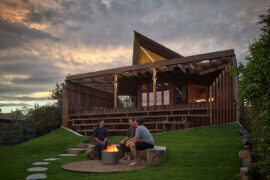Moth Design’s latest retail project is an exercise in creating a lot with a little, we sent Annie Reid along for a closer look
August 28th, 2012
Moth Design has recently fitted out Sleep’n Round’s new Melbourne store, echoing the brand’s bedroom aesthetic on a limited budget.
“It’s very simple, modular and functional. It’s a really raw space with a few really neat elements,” says Moth’s Director, Kate Hannaford.

The project was originally a temporary pop-up but the brief changed as Sleep’n Round’s Managing Director, Andrew Prowse took the plunge and signed a longer lease for a vacant store on Chapel St in Melbourne’s trendy South Yarra.
“I love the rawness and natural look of it, with the pops of colour to bring out our product,” Andrew says.

To achieve the look, Kate needed the wow factors that can often be forgotten with a limited budget, as well as the necessary visual merchandise elements.
One is the Scandinavian-inspired hardwood racking system, comprising various shelves and frames in different heights. The ends of each are painted lime, with small spaces to display the brand’s eclectic products and clothes.

Occasional furniture is at ground level, ranging from terracotta flowerpots in the front window, to assorted chairs complemented with fluorescent, patterned cushions.
“It’s the interior trend of the moment for 20-something, inner city guys and girls,” Kate says.

For lighting, exposed bulbs drape from the ceiling to illuminate the collection on both sides.
“These draw the high ceilings and the rest of the store together,” she says.

While 99 per cent of the existing store was “hideously unusable”, Kate laughs, it only took two weeks to strip it back to create two main sections, and two change rooms at the rear.
The one per cent that was useable was the existing counter, which Kate simply re-clad and moved into a different position.
“We wanted to use what was there but only what suited the store,” she says.
Moth Design
Sleep’n Round
INDESIGN is on instagram
Follow @indesignlive
A searchable and comprehensive guide for specifying leading products and their suppliers
Keep up to date with the latest and greatest from our industry BFF's!

For a closer look behind the creative process, watch this video interview with Sebastian Nash, where he explores the making of King Living’s textile range – from fibre choices to design intent.

For those who appreciate form as much as function, Gaggenau’s latest induction innovation delivers sculpted precision and effortless flexibility, disappearing seamlessly into the surface when not in use.

A career-long quest for substance over style in architecture saw Richard Ho recognised with a ‘Designer of the Year’ accolade at the 2013 President’s Design Award. Narelle Yabuka caught up with this veteran of Singapore architecture to chat about his early years, the honing of his craft, his unique working methods, and three decades of practice.

At the 28th Dulux Colour Awards, designers were celebrated for their unwavering efforts to use colour to elevate architecture and design.
The internet never sleeps! Here's the stuff you might have missed

‘Come Together’ takes a global view of multigenerational design, an increasingly popular phenomenon with some especially notable examples in Australia.

The Australian Institute of Architects has unveiled 43 projects representing the pinnacle of contemporary design, with winners addressing housing, climate and affordability crises through innovative solutions.

CDK Stone’s Natasha Stengos takes us through its Alexandria Selection Centre, where stone choice becomes a sensory experience – from curated spaces, crafted details and a colour-organised selection floor.

Recognised as a winner at the INDE.Awards 2025, Barton Taylor has received The Photographer – Residential accolade. His photographic work on Cake House captures the soul of a coastal icon reimagined, blending light, texture and atmosphere into a compelling visual narrative.